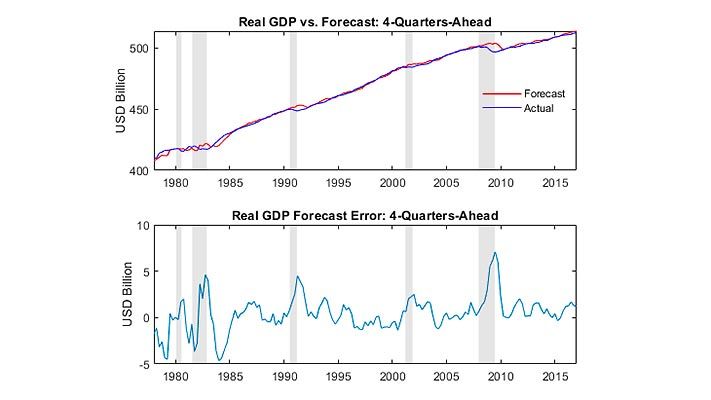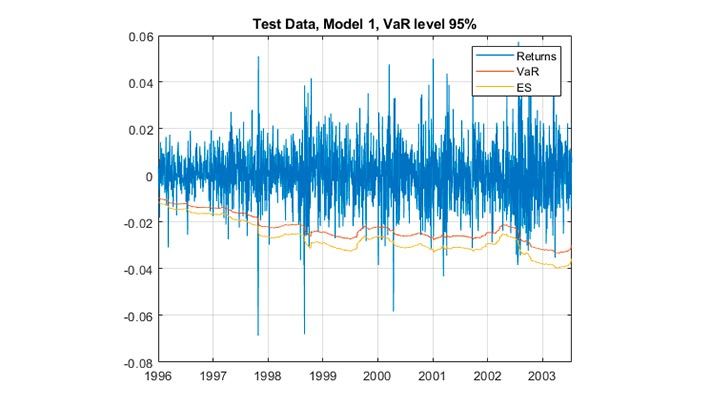Central bank economists and researchers use MATLAB to prototype, validate, deploy, and share financial and economic models in support of critical policy decisions. With MATLAB, you can:
- Use prebuilt apps and tools to pre-process and visualize data
- Fit, simulate, and forecast complex macroeconomic scenarios using univariate and multivariate econometric models
- Use stochastic techniques to model key financial parameters such as GDP, unemployment, inflation, and the economic impact of exogenous shocks such as political disruption, pandemics, and climate change
- Model and manage stress tests and prudential requirements, and maintain orderly markets using machine learning
- Scale, compute, and store data securely in the cloud and integrate with your organization’s enterprise technology infrastructure
- Get technical support, onsite or in-person training, and expert consultant services
“MATLAB provides a fast, flexible, and reliable platform, offering easy integration with other tools and languages. We use MATLAB for data processing, to implement and estimate models, generate forecasts, and construct scenarios. MATLAB’s wide adoption across central banks and economics institutions enables us to leverage the work of others and share our research easily.”
Monetary Policy
- Model complex macroeconomic scenarios to conduct monetary analysis and inform critical monetary policy decisions.
- Use point and click econometric apps for data preprocessing, visualization, and fitting time-series data. Work with univariate and multivariate econometric models in the ARIMA/GARCH family and Bayesian and frequentist vector autoregression models. Share results and generate MATLAB code for repeat use.
- Perform time-based macroeconomic general equilibrium analysis of interactions between economic variables using Dynamic Stochastic General Equilibrium (DSGE) modeling.

Sample fan charts produced by Kiwi Inflation Targeting Technology (KITT).
Learn More
- MATLAB Used to Predict Financial Crises in Emerging Markets
- Third-Party DSGE Modeling Tools: Bayesian Estimation, Analysis and Regression (BEAR), Dynare, and the IRIS Macroeconomic Modeling Toolbox
- Model-Based Monetary Policy Analysis and Forecasting
Code Examples and Documentation

Phase portrait of the Ramsey-Cass-Koopmans system of ordinary differential equations.
Financial Stability and Economic Modeling
- Model key financial parameters such as the GDP, unemployment, inflation, interest rate curves, volatility, default events, and economic growth.
- Analyze multivariate time-series data with structural breaks and unobserved latent states using Markov Switching models. Create and simulate discrete-time Markov chains and time-invariant or time-varying state-space models.
- Model sector and regional economic impacts from exogenous shocks such as political disruption, pandemics, and the physical and transition risks of climate change.
- Automate highly customized reports for policymakers using MATLAB Report Generator or deploying web apps directly with MATLAB Web App Server.
Learn More
- Using MATLAB for Macroeconomic Stress Testing (26:29)
- Design of Modern Forecasting and Policy Analysis Systems at Central Banks (51:37)
- Estimating Market-Implied Value with Jump-Diffusion Models
- Simulating the Ramsey-Cass-Koopmans Model Using MATLAB and Simulink
- Swiss Re Calculates Potential Loss from Natural Disasters
Prudential Regulation, Financial Supervision, and Market Surveillance
- Use MATLAB to model the dynamics and risk management procedures of supervised firms to manage stress tests and prudential requirements.
- Maintain liquid, orderly, and fair markets by analyzing market data, news, and alternative data for suspicious activity.
- Design, calculate, and publish benchmark discount rate yield curves using built-in functions.
- Model and visualize complex integrated financial obligations with graph and network algorithms.

Explore Products

Economic Research
- Explore new ideas using hundreds of built-in MATLAB functions and toolboxes, and collaborate with the wider research community by accessing thousands of functions from the MATLAB Central community.
- Take advantage of the latest advances in machine and deep learning, and natural language processing using point and click apps for training and comparing models.
- Accelerate exploratory programming with Live Editor in MATLAB. Share your work through MATLAB Online and MATLAB Drive.
- Leverage the work of colleagues in different programming languages, such as C, Java, or Python, by calling their code directly from MATLAB.
- Share results by publishing live scripts as HTML, PDF, LaTeX, or Microsoft® Word.
- Create engaging lectures that combine explanatory text, mathematical equations, code, and results.
- Scale complex modeling problems with MATLAB Parallel Server and generate CUDA code for speeding up computation on GPUs.
Code Examples and Documentation
Explore Products
Data Access
- Source market, economic, and alternative data from leading market data providers such as Bloomberg, Refinitiv™, FactSet, and FRED®.
- Access widely used data-sets from statistical agencies using connectors like SDMX, and pull data directly from the web and access any service that exposes a REST API.
- Work with databases and data hubs graphically using the Database Explorer app.
- Access big data storage such as AWS® S3 and Azure® Blob, and use MapReduce solutions such as Spark™, Hadoop®, and DataBricks. Deploy analytics solutions in a microservices architecture managed centrally with MATLAB Production Server, deploy web applications with MATLAB Web App Server, and scale computations with MATLAB Parallel Server.

Use MATLAB with data in HDFS and on Spark.
Learn More
Explore Products

Enterprise Technology Infrastructure
- Provide robust, secure, and responsive services by deploying MATLAB solutions in the cloud or datacenter.
- Deploy MATLAB in the cloud or datacenter for both interactive and production use to bring ‘compute to the data’ in a scalable, secure, and flexible way while minimizing the total-cost-of-ownership and management overhead for IT departments.
- Provision and manage flexible compute resources using containerization technologies such as Docker; reference architectures for cloud platforms; and take advantage of specialized hardware such as GPU acceleration.
- Integrate MATLAB models with Enterprise Dashboards Business Information Systems such as Tableau, SpotFire, Power BI, and Qlik.
- Access full technical support, receive online or in-person training, and engage expert consultants.




